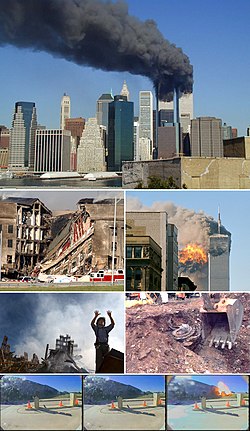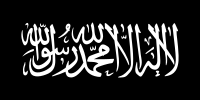al-Qaeda


al-Qaeda[20] (Arabic: القاعدة, al-qāʿidah, "the base"), is an armed Islamic group that was started between August 1988 and late 1989.[21]p75[22] It works as a network, as a stateless army,[23] and a radical Sunni Muslim movement calling for global Jihad. Most of the world thinks it is a Takfiri and a terrorist organization.[24][25]
Members of al-Qaeda have performed many acts of terrorism. Most of these have been done against the United States and Shias. Some of its most well-known attacks have been the September 11 attacks, the bombings of U.S. embassies in Kenya and Tanzania in 1998, and the attack on the U.S. Navy ship USS Cole in 2000. al-Qaeda has done suicide attacks and simultaneous (at the same time) bombings of different targets.[26]
Among al-Qaeda's goals is for other countries to stop influencing Muslim countries and for a new Islamic caliphate to be made. There have been reports that al-Qaeda believes that Christian and Jewish Islamophobia is trying to destroy Islam[27] and that the killing of bystanders and civilians is religiously justified in jihad.
There have been guesses that there are 500–1,000 operatives in Afghanistan and around 5,000 worldwide. However, there is no confirmation of this.
History[edit | edit source]
In June 2001, al-Qaeda and Egyptian Islamic Jihad, which had been associated with each other for many years, merged into 'Qaeda al-Jihad'.[28]
- "...the members of Islamic Jihad and its guiding figure Ayman al-Zawahiri have provided the backbone of [al-Quaeda's] leadership. According to officials in the C.I.A. and the F.B.I., Zawahiri has been responsible for much of the planning of the terrorist operations against the United States".[28]
Death of Osama Bin Laden Laden and current leadership[edit | edit source]
Egyptian Ayman al-Zawahiri is the highest-ranking surviving member of al-Qaeda's leadership after Osama bin Laden was killed on May 2, 2011.
Death of Abu Yahya al-Libi[edit | edit source]
Senior al-Qaeda leader Abu Yahya al-Libi was killed in a drone strike on June 4, 2012.[29] He ranked second to Ayman al-Zawahiri at the time. The strike was carried out in the northwest tribal area of Waziristan. The Pakistan Government has protested to the U.S. about the strike.[29]
References[edit | edit source]
- ↑ Evan Centanni (May 31, 2013). "War in Somalia: Map of Al Shabaab Control (June 2013)". Political Geography Now. Retrieved August 18, 2014.
- ↑ "Prensa Latina News Agency". Retrieved April 12, 2016.
- ↑ "Aden intelligence service building targeted". AFP. Gulf News. August 22, 2015. Retrieved August 22, 2015.
- ↑ Moghadam, Assaf (2008). The Globalization of Martyrdom: Al Qaeda, Salafi Jihad, and the Diffusion of Suicide Attacks. Johns Hopkins University. p. 48. ISBN 978-0-8018-9055-0.
- ↑ Livesey, Bruce (January 25, 2005). "Special Reports – The Salafist Movement: Al Qaeda's New Front". PBS Frontline. WGBH educational foundation. Retrieved October 18, 2011.
Geltzer, Joshua A. (2011). US Counter-Terrorism Strategy and al-Qaeda: Signalling and the Terrorist World-View (Reprint ed.). Routledge. p. 83. ISBN 978-0-415-66452-3. - ↑ Wright, Looming Tower, 2006, p. 79
- ↑ "The Future of Terrorism: What al-Qaida Really Wants". Der Spiegel. September 11, 2001. Archived from the original on March 7, 2012. Retrieved October 18, 2011.
- ↑ "Al-Qaeda seeks global dominance". The Daily Telegraph. London. Archived from the original on January 12, 2012.
"Jihadists Want Global Caliphate". ThePolitic.com. July 27, 2005. Archived from the original on September 30, 2011. Retrieved October 18, 2011.
Pike, John. "Al-Qaida". Globalsecurity.org. Retrieved October 18, 2011.
Burke, Jason (March 21, 2004). "What exactly does al-Qaeda want?". The Guardian. London. - ↑ United States v. Usama bin Laden et al., Cr. 1023, Testimony of Jamal Ahmed Mohamed al-Fadl (SDNY February 6, 2001).
"Al-Qaeda's origins and links". BBC News. July 20, 2004. Retrieved June 3, 2014.
Cooley, John K. (Spring 2003). Unholy Wars: Afghanistan, America and International Terrorism. - ↑ 10.0 10.1 "Conversation With Terror". Time. January 1999. Retrieved March 22, 2015.
- ↑ 11.0 11.1 "October 6, 2002. Appeared in Al-Qala'a website and then The Observer and The Guardian on November 24, 2002". TheGuardian.com. November 24, 2002. Archived from the original on August 26, 2013.
- ↑ "frontline: the terrorist and the superpower: who is bin laden?: interview with osama bin laden (in may 1998)". pbs.org. Archived from the original on May 8, 1999.
- ↑ "New ISIS and Al-Qaeda propaganda prioritize the US and Jews as targets". Anti-Defamation League.
- ↑ "ISIS Augments Its Threats Against Israel". Anti-Defamation League. Archived from the original on August 23, 2017. Retrieved June 6, 2019.
- ↑ Thomas, Carls. "The Saudis channel the mafia: Fears of Saudi retaliation deter truth about 9/11". The Washington Times. Retrieved April 28, 2016.
- ↑ Haaretz; Press, The Associated (July 11, 2017). "Fact Check: Is Qatar Supporting Terrorism? A Look at Its Ties to Iran, ISIS and the Muslim Brotherhood". הארץ – via Haaretz.
- ↑ Study questions Iran-al Qaeda ties, despite U.S. allegations - Reuters
- ↑ Treasury Targets Al Qaida Operatives in Iran
- ↑ "The Chinese regime and the Uyghur dilemma" Summary of Castets, Rémi (2003). "The Uyghurs in Xinjiang – The Malaise Grows". China Perspectives. 2003 (5). doi:10.4000/chinaperspectives.648. Retrieved June 10, 2012.
- ↑ pronounced /ælˈkaɪdə/ (deprecated template) al-KYE-də or /ælˈkeɪdə/ al-KAY-də; alternatively spelled al-Qaida and sometimes al-Qa'ida
- ↑ Bergen, Peter L. (2006). The Osama Bin Laden I Know: An Oral History of Al Qaeda's Leader. Simon and Schuster. ISBN 0-7432-7892-5.
- ↑ United States District Court, Southern District of New York (February 6, 2001). "Testimony of Jamal Ahmad Al-Fadl". United States v. Usama bin Laden. James Martin Center for Nonproliferation Studies. Archived from the original on December 14, 2001. Retrieved September 3, 2008.
- ↑ Gunaratna 2002, pp. 95–96. "al-Qaeda's global network, as we know it today, was created while it was based in Khartoum, from December 1991 till May 1996. To coordinate its overt and covert operations as al-Qaeda's ambitions and resources increased, it developed a decentralised, regional structure. [...] As a global multinational, al-Qaeda makes its constituent nationalities and ethnic groups, of which there are several dozen, responsible for a particular geographic region. Though its modus operandi is cellular, familial relationships play a key role."
See also:- Naím, Moisés (January 2003). "The five wars of globalization". Foreign Policy (134): 28–37. doi:10.2307/3183519. JSTOR 3183519.
- ↑ Ross, Jeffrey Ian (2003). The Dynamics of Political Crime. SAGE. ISBN 978-0-8039-7045-8.
- ↑ 2010 Amil Khan, The Long Struggle, p 88
- ↑ Wright, Lawrence (2006). The Looming Tower: Al-Qaeda and the Road to 9/11. Alfred a Knopf Incorporated. ISBN 0-375-41486-X.
- ↑ Fu'ad Husayn 'al-Zarqawi ... "The Second Generation of al-Qa’ida, Part Fourteen," al-Quds al-Arabi, July 13, 2005
- ↑ 28.0 28.1 Lawrence Wright 2002. The New Yorker. The man behind Bin Laden Archived 2011-02-24 at the Wayback Machine
- ↑ 29.0 29.1 Al-Qaeda commander Abu Yahya al-Libi killed - US officials. BBC News Asia Al-Qaeda commander Abu Yahya al-Libi killed - US officials - BBC News
External links[edit | edit source]
- Council on Foreign Relations al-Qaeda Archived 2010-01-26 at the Wayback Machine
- Gunaratna, Rohan (2002). Inside Al Qaeda (1st ed.). London: C. Hurst & Co. ISBN 1-85065-671-1.
